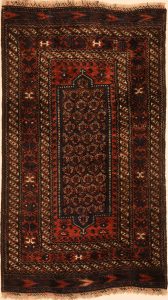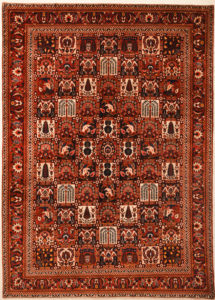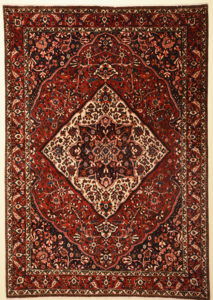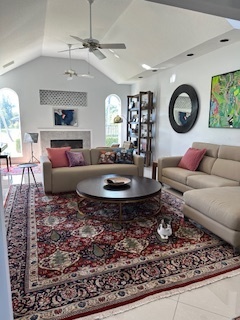Tribal Persian rugs encapsulate the essence of nomadic artistry, crafted by nomadic tribes who traversed the landscapes in search of lush pastures for their herds. The importance of sheep in this context cannot be overstated, as the tribes were always on the move in search of better pastures for their sheep, which provided the wool used in the production of these rugs.
The transient nature of these artisans significantly influenced the aesthetics of their woven creations, leading to unique variations in style, palette, and design.
Drawing inspiration from their ever-changing environments, these weavers harnessed the colors of nature, using dyes derived exclusively from local plants. This organic palette breathed life into an array of patterns, each telling a story of place and tradition, distinct to each tribe’s region.
Highlighting Seven Distinct Types of Persian Tribal Rugs:
raditional Persian tribal rugs are not just home decor but a piece of historical narrative woven into the fabric of their designs, each rug type offering a window into the life, culture, and artistry of the tribe that created it.
Bakhtiari Rugs: Celebrated for their bright colors and vivid hues, Bakhtiari rugs are a festival of colors, with designs bustling in shades of red, green, yellow, brown, and accents of white and ivory. These rugs feature a grid of lavishly adorned squares and compartments, filled with floral and vine motifs, reflecting the robust and durable craftsmanship of their weavers.
Balouchi Rugs: Typically more modest in size, Balouchi rugs captivate with dark, deep dyes of navy blue, navy, burgundy, brown, and black, punctuated by pops of white, ivory, and orange. Common designs include the tree of life and stylized animal footprints, making these rugs popular for spiritual and ceremonial uses.
Gabbeh Rugs: Gabbeh rugs are recognized for their minimalist, symbolic patterns highlighted by a vibrant spectrum of red, orange, and yellow. These simple yet expressive designs are woven into thick, coarse fabrics with a plush texture, often reaching up to one inch in pile height.
Quchan Kurdi Rugs: From the northeastern reaches of Khorasan Province, Quchan Kurdi rugs are known for their stark geometric motifs set against a backdrop of deep burgundy, indigo, ivory, and green. These hand-knotted wool rugs boast a richness that accentuates their straightforward patterns.
Shiraz Rugs: Influenced by a medley of neighboring styles, Shiraz rugs display a diverse array of geometric patterns, often centered around pole medallions. The layered band borders are intricately decorated with botanical motifs, varying in color with the rug’s age, from bold reds and browns in older pieces to milder greens and khakis in newer ones.
Turkoman Rugs: Easily recognizable by their distinctive red and brown geometric patterns and octagonal gul motifs, Turkoman rugs showcase a rich tradition of design. These rugs often feature variations of the gul motif, arranged in meticulous geometrical layouts, evolving from single to double knot weaves over time.
Qashqai Rugs: Named after the diverse Qashqai tribe of southwestern Iran, these rugs are celebrated for their dynamic designs and rich, jewel-toned colors. The Qashqai rugs not only reflect the cultural melting pot of the tribes—comprising Turkoman, Arabs, Lurds, and Kurds—but also their nomadic lifestyle dictated by the rhythmic changes of the seasons.
From Symbols to Stories: Unraveling the Narratives of Tribal Rugs
These rugs are more than just colorful threads; they are woven with meaning. Each pattern and curve tells a story about the weaver’s community, their beliefs, and their connection to nature.
For artists, this rich tapestry of symbols is a chance to explore, interpret, and add their own stories to their work. A musician might be inspired by a mystical bird shown on the rug, while a textile artist might focus on the themes of fertility and growth in the design.
The Most Common Symbols and Designs in Tribal Persian Rugs
Weaving is the foundational process in creating tribal Persian rugs, where each knot and color weaves together not only wool but also the stories and symbols that carry deep meanings for the tribe. This intricate process involves traditional techniques that highlight the individuality and cultural significance of each rug.
Animal Motifs:
Camels and Horses: Often symbolize wealth and status as they are crucial to the nomadic lifestyle.
Birds: Typically represent freedom and the link between heaven and earth.
Lions and Tigers: Usually signify power and courage.
Nature-Inspired Designs:
Floral Patterns: Flowers and leaves are common and are used to symbolize beauty, life, and nature.
Trees: The Tree of Life is a particularly significant motif, symbolizing immortality and divine protection.
Water Elements: Curvilinear forms that resemble water or rain, often symbolizing life and renewal.
Geometric Shapes:
Triangles: May represent mountains or the family unit, consisting of a mother, father, and child.
Diamonds: Often used to symbolize women or the womb, reflecting the matriarchal aspect of tribal culture.
Hexagons and Octagons: Commonly used to create medallions, these shapes can symbolize the evil eye or other protective symbols.
Cosmic and Spiritual Symbols:
Stars and Crosses: These motifs are often used to represent spirituality, guidance, and faith.
Amulets and Talismans: Woven into rugs to ward off evil spirits and bring good luck to the household.
Sufi Symbols: Used in rugs made by tribes with strong spiritual practices, representing mystical elements of their beliefs.
Everyday Life and Fertility:
Comb and Pitcher Designs: Symbolize cleanliness and purity, essential aspects of daily life and spiritual practice.
Ewer (Water Jug) Motifs: Represent water as a source of life, often used to express wishes for prosperity and fertility.
Borders and Guard Stripes:
Guard Stripes: These often contain smaller repeating motifs that serve as protective barriers for the central design.
Interlocking Borders: May symbolize the interconnectedness of life and the community, or serve as a charm to keep the central design secure.
Tribal Persian rugs are more than exquisite art pieces; they are profound expressions of cultural identity and history. Each rug, with its unique patterns and vibrant colors, tells a story reflective of the rich nomadic heritage of its creators, using symbols and designs to depict life, beliefs, and the environment of the tribal communities.
These narratives, woven from wool and natural dyes, serve as a language through which weavers express their worldviews, making each rug not just a decorative item but a keeper of stories and a carrier of cultural legacy.
















